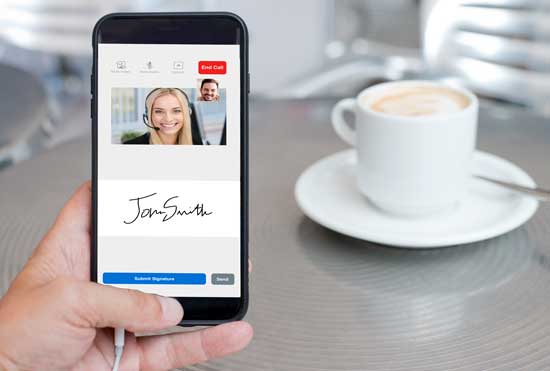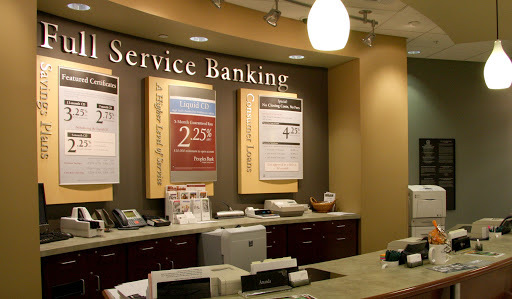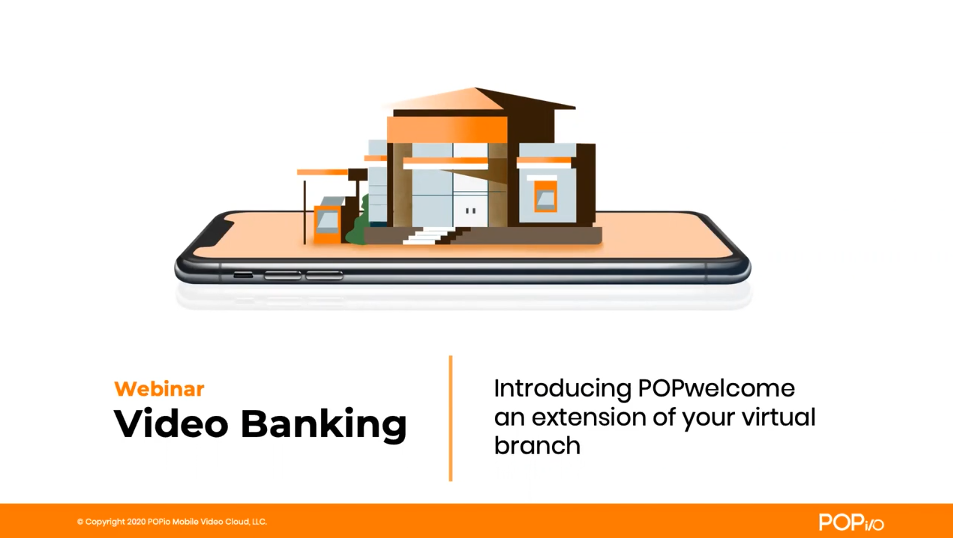POPwelcome is the best way to engage with your consumer through the digital channel of their choice, chat, voice, or video. Customer Service Representatives can then answer questions, co-browse webpages, and seamlessly transition the call to voice or video to elaborate on available products and services. See a demonstration and learn how this new feature can help you.
For more information about video banking, request a free demonstration.
For more information about video banking, request a free demonstration.

 Remember back before the pandemic, when traditional financial institutions’ greatest concern was relevance? Today with Covid-19 concerns, FI executives are consumed by the need to deliver touchless service while managing new concerns about employee safety, dwindling earnings, loan losses, and capital.
Remember back before the pandemic, when traditional financial institutions’ greatest concern was relevance? Today with Covid-19 concerns, FI executives are consumed by the need to deliver touchless service while managing new concerns about employee safety, dwindling earnings, loan losses, and capital.
As a result, relevance has moved down on the priority list. While relevance may not be an immediate priority, the need for it remains high. Consumers understand or perhaps don’t care if an organization struggles with financial or regulatory concerns, they just want a relevant provider to serve their needs.
InRoads Credit Union is a $288 million community-chartered institution headquartered in St. Helens, Ore., a town of approximately 13,000 people. In St. Helens, $288 million in assets buys a lot more relevance than in nearby Portland. Still, President/CEO Brooke Van Vleet, who began her credit union career in the marketing discipline, recognizes the value of continuing to evolve that strong brand with the times. She and the InRoads team knew the credit union needed to continue investment into their digital services to remain relevant in their marketplace and ensure a sustainable future.
In 2019, InRoads went all-in on ITM drive-thru service for teller services and POPi/o’s Video Banking solutions for both mobile and in-branch video consultations. The goal was to provide members with a combination of digital convenience and face-to-face service to meet member’s needs. In the very early stages, members’ response to the new technology was lukewarm, that is until COVID-19 shuttered the community and InRoads closed all of its branches. Suddenly, video became the only way to get face-to-face service and adoption quickly grew four times over.

Preston recalled another member who refused to use video banking, loudly demanding that he sit across the table from a live human being. A branch employee eventually convinced him to just give the service a try. As he emerged from the video banking office and headed for the lobby door, the teller said, “Bye, see you later!” “No you won’t,” he said, “I’m using this from now on.” And just like that, InRoads gained relevance from a member who was perfectly happy with the status quo.
Chief Experience Officer, Ron Winter, explained that rolling out new technology and asking a small town community to adopt it isn’t always well-received. However, when the pandemic hit and InRoads already had a solution that was not only safe, but also maintained face-to-face service, perception of the credit union shifted in Columbia County. InRoads became the most relevant game in town. “It certainly positions us differently than six months ago,” Winter said. Video banking was a perfect complement to the new branding initiative the credit union began in 2018, in conjunction with its name change. In fact, video banking has become a cornerstone of how InRoads plans to serve members in the future. “We’ve talked a lot about what traditional used to mean, and I don’t think we’ll ever build another branch the way we used to,” he said. “Yes, we will have brick and mortar, but it will be different. Video banking will allow members to speak with a subject matter expert from anywhere. Even if you visit a small location, we can connect you to a commercial mortgage loan officer or whomever you need. That’s the vision.”
To learn how POPi/o Video Banking can help your financial institutions maintain relevance and personal service, request a FREE demo.

 I’m a big fan of the convenience of digital services, unfortunately, most deployments are targeted to such narrow use cases that it doesn’t address most consumer’s needs. This is especially the case for more complex financial service products. It shouldn’t be that difficult, right? Consumers should just go to the FI’s website, find the products they want and “sign-up”, or in the model of Amazon, add the product to their “online shopping cart”. Yet as branch traffic dwindles and digital adoption grows financial institutions are finding that their “online shopping cart” abandonment rates remain sky-high.
I’m a big fan of the convenience of digital services, unfortunately, most deployments are targeted to such narrow use cases that it doesn’t address most consumer’s needs. This is especially the case for more complex financial service products. It shouldn’t be that difficult, right? Consumers should just go to the FI’s website, find the products they want and “sign-up”, or in the model of Amazon, add the product to their “online shopping cart”. Yet as branch traffic dwindles and digital adoption grows financial institutions are finding that their “online shopping cart” abandonment rates remain sky-high.
According to research by UK-based behavioral marketing company SaleCycle, the financial sector has the highest global online shopping cart abandonment rate at 83.6%. The overall average for all sectors wasn’t much better at 75.6%.
Why so high? In general, digital channels are a one-way experience. Closing a sale has traditionally been a five-step process that requires two-way communication, which is missing in digital sales interactions.
Below are the five most common sales steps:
- Introduction
- Discovery
- Offer
- Objections
- Close
Research shows a variety of reasons online carts are abandoned; however, they all have one thing in common, a stalled sales process. But Video Banking can help since it provides a customer experience that combines two-way, face-to-face service with the convenience, security, and efficiency expected with digital interactions. When Video Banking is leveraged to its full potential it can become the ultimate sales channel, providing financial institutions the ability to take a customer through all five sales steps in just one call.
Let’s examine how Video Banking supports these five sales steps.
Introduction
For institutions focused on increasing wallet share, the introduction and rapport building stage are already occurring while providing service to existing customers. Video banking provides an ideal channel to discuss complex transactions, solve problems, and ultimately builds rapport that leads to additional sales. Video banking helps build trust quickly with prospective and new customers in the moment of need when facing major life events. Our customers expressed the value of providing an empathic face with video while discussing consumer loan modifications and payment plans during the recent branch closures.
Discovery
Video banking allows your customer service representative (CSR) to initiate conversations that reveal unmet financial needs, which is the purpose of the discovery step. Customized digital sales pages backed by data and artificial intelligence (AI) can perform better than general digital sales tools, but only a live CSR can listen to the customer’s needs and effectively tailor their sales pitch or presentation accordingly.
Offer
No matter how well you craft an online offer and sales page, it will never compare to a well delivered presentation by an experienced CSR. Video banking can integrate professional presentation tools that add consistency and polish to your message. And, a two-way conversation during the offer step allows CSR’s to confirm that they are matching the customer’s needs with the right features and benefits of your product.
Objections
Handling objections is where two-way communication truly shines. Data and AI can anticipate which objections a digital customer may have, but video banking has a definite advantage with two-way communication that effectively identifies objections and provides the opportunity to answer questions. Additional POPi/o tools like dynamic call routing, warm transfers make accessing the right experts easy. Plus our Positivity Coach feature allows the CSR to monitor the consumer’s reaction and adjust if emotions indicate some fear or trepidation.
Close
The most important step in making a sale is asking for the business and closing the deal. However, even expertly optimized digital sales pages convert just 20% of leads. That’s because the close step can only be completed if the previous four steps were successful. Your seasoned CSRs knows when all questions and objections have been addressed and when the time is right to close the deal.. With this step, it’s essential that Video Banking tools include workflow abilities like E-sign, document exchange, and screen share, to allow for the product purchase to be finalized before the video chat ends.
Introducing POPwelcome
It’s the extra tools and system integrations that make the POPi/o Video Banking app so robust and successful. However, not all customers have downloaded the app onto their mobile devices. For customers that are browsing an FI’s webpage, your representatives can now use POPi/o’s new POPWelcome for online or mobile chat messaging, providing a truly omnichannel experience by seamlessly transitioning the customer from text chat to video banking.
Personalized service sets community financial institutions apart from national and global competitors. However, without sales, no company can prosper and grow. No matter the size of your institution, you must provide your sales team with technology that allows them to provide the best of digital and face-to-face service, without any disruption to the five-step sales process. Video banking can provide that experience. To learn more about how quickly and effectively POPi/o Video Banking can boost your digital sales conversions, request a free demonstration with a video representative.
For more information about video banking, request a free demonstration.
For more information about video banking, request a free demonstration.
Webinar Highlights
Effects and Trends from Covid-19 - 2:43
Changing to the New Normal - 24:00
The New Face of Your Branch - 27:45
Video Banking Post Covid-19 - 30:16
Technology For In-Branch Transactions - 41:10
Branch/Call Center Design to Consider - 46:35
For more information about video banking, request a free demonstration.

 Digital service providers are reporting explosive increases in user data over the past two months as shelter-in-place orders have forced consumers to go digital. Attitudes toward digital have seemingly changed overnight – what was once a user experience enhancement is now literally an essential service channel.
Digital service providers are reporting explosive increases in user data over the past two months as shelter-in-place orders have forced consumers to go digital. Attitudes toward digital have seemingly changed overnight – what was once a user experience enhancement is now literally an essential service channel.
The term disruption had run its course before COVID-19, but this largely unexpected even is just that, a major disruption for nearly every sector. Now that we’re about three months into this global pandemic, financial institutions are no longer wondering if, but how much COVID-19 will change the way they deliver products and services.
The answer could mean shuttering even more branches and once again rethinking branch strategy. Consider this: increased digital adoption won’t be the only drain on branch traffic. Experts say the stay-at-home environment could be a way of life for a long time. Certain groups of people, including retirees, those with compromised immune systems, and those fearful of infectious disease may forever avoid in-person interactions.
There’s more. Experts say social distancing could be required by authorities well beyond 2020.
As long as someone in the world has COVID-19 and there is no vaccine or herd immunity, breakouts can and will keep recurring without stringent controls, wrote MIT Technology Review Editor-in-Chief Gideon Lichfield. Even if social distancing measures are only put into place every time ICU admissions begin to spike, research models predict that strategy would still require a schedule of roughly two months under quarantine and one-off.
Harvard disease experts agree, saying that some form of intermittent social distancing may need to be in place until 2022 and possibly longer.
Social distancing is beginning to be referred to as physical distancing, which is a more accurate description. Despite being physically separated by quarantine, people have still found ways to be social. Neighbors have entertained each other around the world with balcony musical performances. Friends and family have honored graduates and birthdays with car parades. We’ve turned video conferencing into virtual happy hours that even have their own signature drink, the Quarantini.
Those under COVID-19 quarantine have shown that while they are willing to adhere to physical distancing, they still require face-to-face contact, even if it’s via video. To maintain brand loyalty, financial institutions will need to find ways to provide that level of human service. Many of them will have to find ways to make branching work despite the challenges, which will likely include the need to keep everyone at least six feet away from each other, limiting people in the branch at one time and increased personal hygiene and cleaning standards.
The solution lies in using technology in new, creative ways to provide meaningful social interaction, just as parents have created virtual graduation and birthday parties for their children. We’ve seen credit unions and banks integrate video banking like POPi/o into their branches in creative ways that provide a superior user experience while also supporting the institution’s bottom line.
For example, one financial institution completely centralized its lending operations, even going as far as to restructure branch employee incentives to guarantee their support of video banking in lending. To ensure privacy, an office in each branch was reserved exclusively for video banking sessions. This institution already had a pandemic-friendly branch strategy that minimizes employee exposure and maintains excellent physical distancing between two groups of customers: those completing transactions and borrowers.
Another video banking institution has closed its branches to walk-up traffic, performing only select services for customers by appointment only. However, it had already installed personal video teller machines outside of the lobby, providing an on-demand way to accept check and cash deposits, make cash withdrawals, and, if needed, connect to a live video teller who can perform more robust transactions and problem-solving. Time will tell if this strategy will work long term, but because video tellers had already been integrated into the branch strategy – even if only intended to extend service hours, not perform essential services during a national emergency – this financial institution didn’t skip a beat providing full branch service while being a good corporate citizen.
Are you frustrated with what seems like no-win options to adjust your branching strategy to physical distancing and other measures that will keep your employees and customers safe? Let POPi/o help you brainstorm ways your financial institution can use video banking to quickly and effectively meet the needs of your customers and your bottom line.


Throughout history, major events have created permanent, unexpected shifts in human behavior. People have been forced into lockdown to stop the spread of disease before; the long-term psychological effects of those quarantines have been studied, so we have some idea of what to expect. However, the length and global reach of this isolation are unmatched, and there is no doubt this traumatic event will produce permanent changes.
Here are three impacts of COVID-19 and their respective long-term outcome for community banks and credit unions.
Fear of public gatherings
After this pandemic has long passed, a generational shift will produce new preferences when it comes to public gatherings and face-to-face interactions. Following previous outbreaks in Asia, face masks became a normal and expected day-to-day accessory. With the fear of contagions and mandatory stay-at-home orders, people are becoming more comfortable replacing physical interactions with digital visits. The long-term shift will come as many start preferring it as a way to manage lingering fears of contracting a fatal disease. Perhaps you’ve already seen this fear play out on social media in emotional debates about whether or not a COVID-19 vaccine is required before reinstating sporting events, concerts, and other large public gatherings. In particular, subsets of the general population who are concerned about germs will be more sensitive to the risks involved.
The effect on FIs: Traffic at branches has been decreasing for years; however, fear combined with increased digital channel adoption will send this trend into overdrive. After all, it’s mostly older consumers who still use branches, and this age group will be understandably shaken by losing friends to COVID-19. However, older generations also value face-to-face service and prefer doing business with specific employees. Not only will video banking fill that service gap for this market, but adoption will also be easier than ever because so many grandparents have been using video to communicate with family during the quarantine.
We’ve said for years that consumers want to choose how they engage with their FI. If they can do it all digitally, more power to them. But in tumultuous times like now, people need more help from real people. Maybe they can’t pay their existing monthly loan payment due to reduced hours. Do they refinance the existing loan? Roll it into a HELOC? Find another solution? To solve this problem, they need a financial counselor, and that’s something credit unions and community banks can and should offer. Video banking supports that consultative relationship while still protecting the consumer and employees.
Economic shifts
I’m confident that the stock market and U.S. economy will survive and continue to lead the world; however, segments of the economy already affected by quarantine orders may not completely recover. Small restaurants, travel industries, commercial real estate, and auto industries are all likely to face a protracted slowdown.
The effect on FIs: Financial institutions that serve these industries will suffer resultant impacts on their businesses as well. Although markets shift and change every day, this change is so drastic and unexpected, we may see some financial institutions fail or merge for survival similar to the mortgage meltdown in the late 2000s. Those looking to thrive must find ways to economically provide their services. Again, we see video banking as a possible solution for cost-conscious service delivery.
Work from home
Now that a majority of U.S. workers are gaining remote work experience, a return to the office will be a tough sell. Let’s start with the dress code: sales figures from Walmart that report the chain selling out of tops but not pants. Americans have happily embraced new workplace standards that only require professionalism from the waist up and allow for interruptions from children during meetings.
The effect on FIs: Like everyone else in America, financial services employees will want to continue to work from home. Working from home and the schedule flexibility it will bring could create the need for, and ability to offer, longer service hours. While that might be possible from a technology standpoint, security will be an issue for FIs, because video conferencing apps like Zoom they weren’t built to handle secure financial information and workflows. We’ve helped our customers use the POPi/o platform to not only serve customers securely but also support employees who must now work from home and handle sensitive consumer information.
Change isn’t easy for anyone. Big external events (like a global pandemic) create new circumstances and could be the stimulus for permanent change. Good luck to you and your financial institution as you navigate the new normal post-Covid-19.

POPi/o Covid-19 Response

As I write this, the coronavirus death toll in the U.S. has risen to 6,574, and that number is sure to rise by the time you are reading this. Every state in the union has announced positive cases of Covid-19 and most have declared mandatory shelter in place orders. The financial markets have continued to tumble throughout the month of March and the Federal Reserve Board announced its first emergency rate cut since the 2008 financial crisis.
The fatality rate for Covid-19 isn’t as high as other viruses, but what seems to make Covid-19 frightening is how contagious it seems to be. Evidence that Covid-19 is more contagious than estimated lies in the numbers: the virus has reached 210 countries on six continents in a matter of weeks, and many of the infected report no contact with anyone known to be exposed to the virus.
At a time like this, how does a Financial Institution protect their staff and consumers? Most FI’s are choosing to close branches. During the month of March, I talked to hundreds of FI’s. In those meetings, I learned that most branch lobbies remained open on March 16th, but by the end of that week and early into the following week, the majority of branch lobbies had closed or restricted their access.
With this restricted access to physical locations, how can FI’s maintain business continuity? Amid the fear, there is some positive news: today’s technology allows financial institutions to provide essential services much easier than during previous pandemics. During the SARS outbreak of 2002, when most financial institutions last updated their business continuity plans, customers utilized call centers, ATMs and online banking services. These days, technology has enabled several additional tools such as mobile banking, mobile check deposit, video teller machines (ITMs), and video banking tools.
This transition to new technologies is happening already. Within 10 days of Covid-19 hitting the U.S. shores, our video banking company, POPi/o, saw video call volume jump 50%. We also saw a rapid shift from our in-branch video call volume to mobile and web video calls. Other financial services providers report digital channel traffic over the last few months to be equal to traffic during all of 2019. We expect traffic to continue growing.
During this pandemic, consumers need access to your FI resources more now than ever. Whether they need to discuss loan modifications or to apply for the government’s payroll protection program, consumer needs are just as high as their anxieties. Video Banking tools can assist financial institutions when they are forced to close branches, or when consumers are unable to leave their homes. FI’s can now deliver teller services from Interactive Teller Machines and with POPi/o Video Banking offer in-depth banking consultations and account services. Today’s Video banking is far more robust than basic communication via phone or video conferencing and allows for new accounts, loan origination, funding new accounts, exchanging documents, signing applications, and any number of account servicing needs.
Before today’s recent events, many of our credit union and bank clients have found POPi/o video banking to be useful in assisting customers who are homebound due to age, illness or disability. Others used it to assist professionals in medical, military or other circumstances that didn’t allow for quick trips to a branch. Now we see personal branch services being delivered to consumers in self-isolation, oftentimes with the staff member safely working from home.
If your credit union or bank is reviewing their business continuity plan and looking for additional ways to provide essential services using digital channels, request a demonstration or give us a call. We’d be glad to discuss how video banking can become an integral part of pandemic mitigation that protects your staff and consumers. Until then, stay safe, and healthy.
For more information about video banking, request a free demonstration.

The Holidays are a time to reflect upon the past year and focus on gratitude and service. Gratitude can take many forms, such as feeling grateful for financial success, heartwarming gifts, the important people in your life, and even the wisdom you’ve gained from life’s ups and downs of the past year. As we dig even deeper into gratitude we begin to feel grateful for the things we take for granted, like our health, mobility, food, clean drinking water and even our freedom.
Freedom isn’t just political; it means different things to different people.

According to the Center for Disease Control, more than one in four adults in the United States live with some type of disability. The most common disability is a lack of mobility, which makes the freedom of being able to walk severely difficult or impossible for nearly 14% of Americans.
Many of us take for granted the freedom of being able to handle day-to-day tasks on our own without relying on help from someone else.
When we first started exploring video banking and the impact it would have on people’s lives, we always focused on convenience and how to get services directly to a consumer without friction. Never once did we think it could help so many gain freedom in the way they banked.
But we are incredibly grateful it did.
For example, Idaho Central Credit Union a $4.8 billion credit union headquartered in Chubbuck, Idaho, was able to use video banking to serve a quadriplegic member face-to-face that was an hour away from any branch location. The ability to see and talk to his loan officer allowed him to feel like a piece of independence was given back to him. Service provides assistance to those in need, even when you’re not aware of it, and we are grateful video banking was able to help this happen.
Cobalt Credit Union, a $1 billion institution in Council Bluffs, Iowa, shared a different kind of assistance success story. This member, who is deaf, wasn’t able to access the credit union’s call center and if they needed assistance beyond what was available online or through the mobile banking app, they had to visit a branch in person. With Cobalt’s new video banking channel, however, the member was able to both see the representative on screen and use the app’s chat feature to clarify their banking needs. Now, this member can enjoy full service, at-home banking. We are grateful video banking was able to change how this member interacted and accomplished their banking needs.
Pioneer Federal Credit Union, a $500 million institution located in Mountain Home, Idaho, was able to serve a member who was severely injured in a rodeo accident and had to adjust to depending upon others to assist with their financial transactions and business. We hear a lot about accessibility when it comes to your financial institution’s digital channels, but providing accessibility to your people can mean the world to those in need. We are grateful Pioneer was able to go above and beyond with video to help serve this member and countless others who have let Pioneer know that this engagement channel “has given them their freedom back.”
There are countless more stories of how video banking has supported financial freedom and accessibility. We’ve heard about pilots making video banking calls from the tarmac, consumers accessing financial assistance via video from overseas, parents receiving face-to-face service without having to drag kids along to the branch, and working class Americans who were finally able to connect and accomplish their financial needs.
We didn’t anticipate video banking would change lives. But this Holiday season, as we reflect upon the past year, we are beyond grateful that it did.





